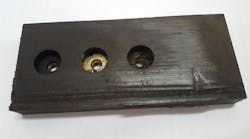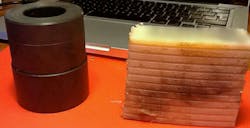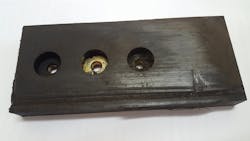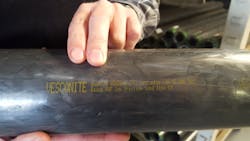Download this article as a .PDF
Four years ago, a large freighter was on a typical voyage when the captain and crew discovered the ship could not be steered. It couldn’t even move in a straight line. Instead it turned in circles over the open ocean. It was a ship owner and crew’s worse nightmare, as the ship with a dead weight of almost 40,000 ton followed its own path.
The container vessel was eventually towed to the nearest port and various causes were investigated, including the meter-diameter rudder bushing, which was found to be at fault. The bushing had been replaced three months earlier and, despite the specification being for Vesconite, a dimensionally-stable polymer suitable for underwater applications, a moisture-absorbing nylon rudder bushing was installed instead.
The third-party-supplied nylon bushing swelled and eventually seized to the shaft, preventing the rudder from executing the actions necessary to let the ship continue to its destination.
Towing, dry dock, and consulting engineer fees—including a call-out from Vesconite Bearings to the port—resulted in significant costs well in excess of what a bona fide Vesconite rudder bushing would have cost.
The lesson: There is no doubt that piracy and counterfeiting are significant issues globally, even among items that one commonly does not expect to be counterfeited such as bushings and bearings. This can have a costly effect on businesses that use them either knowingly or unwittingly.
Bogus Polymer Bearings and Bushings
To Vesconite Bearings’ knowledge, there have been no consolidated studies into the counterfeiting of polymer bearing and bushing. But the company has plenty of its own evidence from concerned would-be clients, as well as anecdotal evidence from others on counterfeit parts in both critical and non-critical applications. Evidence also shows criminals counterfeiting both the finished products, bushings, and bearings, and also the raw materials used to make them, including various high-performance polymers.
These two industries—bushing and bearing manufacturers and polymer suppliers—may be especially prone to counterfeiting since they both often have:
• Strong brand power developed by producing quality products over the years.
• Considerable global logistic, distribution, and supplier networks that may be difficult to police.
• High prices as a result of considerable raw material, engineering development, and technology inputs, and these prices may act as an incentive for the unethical and unscrupulous who want to cut corners and costs.
• The likelihood of being sold into developing countries where the risk of discovery and prosecution are low, and the penalties if caught are not prohibitive.
The Dangers of Counterfeit Products
Counterfeit products can hurt the bottom line of the companies that buys them and the companies that make the original articles, the real McCoys, and in several ways:
Brand collateral. Counterfeiters often prey on companies which have genuine brand power and are trusted among buyers. Buyers typically believe they have purchased a genuine product, so they get disillusioned (and mad) with a brand if the copy-cat version does not perform up to the manufacturer’s usual standard. This happens when bearings or bushings are poor replicas of the original ones and with imitation polymers that may not have the characteristics of the specified required polymer. It may, for instance degrade when exposed to ultraviolet light, have little resistance to solvents and chemicals, or relax and weaken under long-term loading.
Cost of doing business. If polymer bushings and bearings fail catastrophically or wear prematurely, it can cause expensive production downtime or equipment break downs. This can increase the cost of doing business and could, ultimately, result in company closures if costs related to failures push operating or capital expenditure costs beyond acceptable levels.
For the manufacturer of the copied parts or polymers, the costs to protect and authenticate genuine parts may have to increase too, as increasingly sophisticated measures have to be employed.
Economic damage. The cost to countries home to manufacturers can be considerable. Many associations and companies involved in combatting counterfeiting track the number of jobs that might be added to the economy, the decrease in the cost of doing business, and the increase in profitability of doing business if counterfeiting was stopped.
In addition, tax losses can result from undeclared manufacturing, and policing costs can increase as governments are expected to enforce intellectual property rights and prosecute those infringing on them.
Critical applications. Some applications in which polymer bushings are used are critical and there may be health and safety implications if the bushings fail.
Fighting Back
In the bearing and bushing sphere, various companies are taking an active stance against the sale of counterfeit items. Some companies offer authentication apps and invite users to email photos of suspected counterfeit products to them. Some have embarked on legal proceedings against counterfeit dealers and many have been active in the press denouncing those who use their company brand without permission, giving users the false impression that they are buying original guaranteed parts. There is also an international campaign supported by some large bearing manufacturers to encourage awareness of the prevalence of counterfeit bearings.
Engineered polymers, meanwhile, are also threatened by counterfeiters intent on trading on well-established brand names to sell inferior products, as a recent high-profile case that resulted in automotive recalls attests.
Manufacturers have responded by introducing various overt and covert methods to identify their products. Vesconite Bearings, for instance, places identifying labelled stickers on its full-length rods, hollow bars and plates, with a green sticker on its Vesconite polymer and a blue one on its Vesconite Hilube polymer. It puts printing over stretches of the product which lists the polymer name, batch number, and measurements.
In addition, some companies, including Vesconite Bearings, issue material certificates that accompany their materials. These should be obtainable even where their polymers are bought through third parties.
As a first step though, users should know the products they are buying and conduct their own visual inspections. There are also various measures buyers can take to ensure they have a genuine polymer bushing For example:
Engage with the manufacturers. Many companies that manufacture polymers sell their products directly to the public. Products sold this way are guaranteed to be the original specified material.
Manufacturers that use third parties to sell their polymers have a database of these suppliers. If a user or buyer suspects their supplier may not be a legitimate source of verified products, the original manufacturer can be contacted to verify whether the supplier is known.
Manufacturers, whether they sell directly to the public or through third parties, should be able to supply a conformance or material certificate. This is a warranty that the material being purchased is what is stated on the certificate, and it can provide peace of mind for the user.
Know your polymers. Users should visually inspect materials to ascertain they have received the correct one. Legitimate manufacturers can describe the polymer’s visual characteristics and, if that polymer does not conform to this, chances are it is not the polymer that was specified.
Even a visual inspection is not enough to ensure the polymer being used is what it claims to be though, as some products are marketed by unscrupulous polymer dealers who match polymer colors of well-known and respected companies to persuade users a particular polymer is authentic.
A small piece of the polymer can, however, be burnt if there is doubt of its authenticity. Nylon smells like burnt hair, while polypropylene and polyethylene smell like candle wax or paraffin, for instance.
The material can also be exposed to battery acid. Polytetrafluoroethylene (Teflon or PTFE) and polyethylene will not be affected, but acidic fumes may be released from nylon, although different fillers may increase the resistance of nylon to acid.
Hardness is another method of determining which polymer you have. With most nylons, for instance, they becoming softer when immersed in water or exposed to moisture.
Be aware of costs. If the price is considerably lower than you would expect, chances are that a counterfeiter may have replaced the specified material with an inferior polymer. It would be best to know the quoted price of a polymer is if obtained from the original manufacturer.
The Outlook for Counterfeiting
It seems counterfeiting is growing with the global economy despite moves by manufacturers and host and supplied nations to stop the flow of these illicit goods. Both manufacturers and countries continue to step up their responses to counterfeiting, aware of its potential negative effects.
Customers, in turn, also need to know of the dangers of counterfeiting; buyers especially should be knowledgeable about the dangers of purchasing cheaper copy-cat products that may not meet the specifications of the engineering team.
Buyers can be under considerable pressure to meet performance targets, but, as in the example of the counterfeit rudder bushing, they should ensure that those they report to are cognisant that purchasing costs can only be brought down by a certain percentage and that the purchasing of counterfeit goods that do not meet specifications should be avoided.
There Be Pirates Out There
The International Chamber of Commerce estimated that the sum of global counterfeit goods came to $650 billion each year around 2008 and that it could climb to $1.77 trillion in 2015. It also projected that pirate and counterfeit goods cost 2.5 million jobs globally.
For the U.S., pirated goods and counterfeits cost up to $250-billion and 750,000 jobs annually, according to the FBI.
Apparel, electronics, toys, medication, food, wine, cosmetics and cigarettes are some of the products that have been worst affected by piracy and counterfeiting, and they have been linked to the drug trade, money laundering and terrorism. Other sectors have also not been spared, although their counterfeiting may not be as extensive.
As a result, buyers of even the most innocuous products, such as polymer bushings, might want to also think about piracy and counterfeiting.





